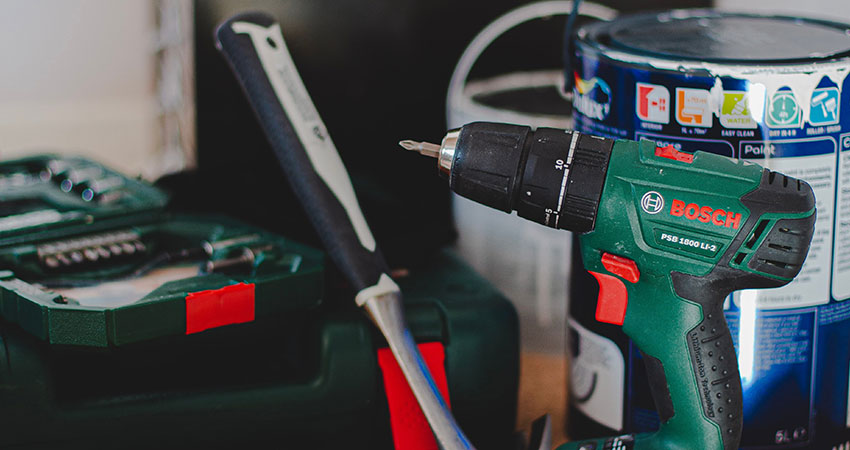Some random home improvement tools; (photo credit: Sam Clarke on Unsplash)
Home improvement shopping season is in full swing. That means customers are perusing everything from light fixtures to kitchen tiles to porcelain toilets. Why? Spring is a symbol of new beginnings, and that has historically translated to spikes in home-refreshing purchases. Unfortunately, spring is also a sign that retailers are entering one of the most logistically challenging and costly returns seasons of the year.
Here we’ll review major returns issues following home improvement season and what retailers can do to mitigate the fallout.
Bulky Returns
Home improvement returns are complicated, regardless of the category or size. But overweight returns like toilets, vanities and cabinets present some of the most complex challenges retailers for retailers to mitigate:
Damage
When a customer buys bulky home improvement products, the items arrive neatly packaged and secured. But once customers open the box, take the item out, decide they don’t want it, and stuff it back in the packaging, all quality-control bets are off.
Typically, when customers bring these items back to the store or ship them to a returns center, the once pristine item arrives with some level of damage – ranging from a small crack to thousands of pieces. Another common occurrence is the customer forgets to include a few small components, like a shelf or chord, rendering the package useless. Whether scratched, cracked, broken, or incomplete, these items are not eligible for resale, and the retailer will usually take a loss if they can’t send the items back to the vendor for credit.
Processing Costs
Online returns make matters worse because retailers must pay to ship the items to collection centers, and eventually to the final buyer in the secondary market. Plus, bulkier returns–are much more expensive to ship.
Normally, logistics companies pack dozens of items on every pallet to reduce the shipping cost. But bulky products take up significantly more space, making them more expensive to transport. In our experience, oversized home improvement returns can cost up to 10 times more to transport than standard-sized products. Additionally, retailers must pay for more personnel to sort, inspect and repackage these heavy items. Every time a worker touches a return, retailers must cover the cost.
Due to these challenges, most retailers don’t have a sound returns strategy for these items and as a result, our data shows that a typical organization recovers less than 10% on these items, at best.
Resale Challenges
In typical returns scenarios, retailers often work with liquidation companies to sell unwanted and distressed goods in bulk at a discount. However, used and oversized home improvement returns are specialty items that don’t have the same secondary market appeal. As a result, most liquidation companies don’t want to purchase these returns from retailers, even at a significant markdown, which means retailers must seek specialty customers who often pay even lower prices.
Retailers could use technology to determine the most optimal resale route. They could also utilize recommerce software to automatically resell bulky items online in local markets. However, many don’t have the systems and supply chain to execute these specialty strategies, resulting in, many home improvement returns get thrown away.
Ecommerce: The Gift and the Curse
Since the onset of COVID-19, customers have turned to ecommerce for their purchases, and it’s likely that home improvement items were added to these lists. And as most industry experts know, customers return two to three times more ecommerce purchases than in store. As a result, we’ve seen cases where retailers are processing double the amount of returns annually compared to pre-pandemic times. On top of that, retailers are paying the price for increased shipping costs and damage risks in transit.
Despite the trifecta of challenges, omnichannel retailers haven’t adjusted online returns policies to mitigate the loss. Instead, retailers remain committed to meeting customer demands for convenience, free shipping, and rapid refunds. Customer loyalty is priority number one, so retailers must rethink their reverse supply chain strategy for the new normal.
The Advantage of a Reverse Supply Chain
Retailers have extensive forward supply chains and warehouses to receive, sell, and ship new items. Returns, however, are much less systematic and require vastly different spaces, personnel, and procedures that retailers often do not have. So, enterprise organizations must consider one of two options: invest in reverse supply chain infrastructure across the country or partner with a returns management provider that can offer economies of scale.
End-to-end returns management providers exist to find ways to reduce costs and recover more value from every eligible return. A best-in-class reverse supply chain offers:
- Physical returns centers to process items
- Transportation management with consolidation to reduce shipping costs
- Automation technology to reduce processing time
- Labeling systems to efficiently move items out of the warehouse to the proper secondary channels
Retailers can also deploy technology online or in-store right from the point of return to take advantage of features, like geolocation-based shipping services. Additionally, technology can make “keep it” recommendations for products that are not worth the processing costs. So, instead of paying for return shipping on low-value or bulky items, retailers can utilize the technology to offer return-less refunds or discounts to incentivize customers to keep those items.
The Bottom Line
Home improvement seasons translate to more expensive returns for every retailer in this category. Plus, online orders mean retailers must manage significantly more items. Without reverse infrastructure, economies of scale, and technologies that process returns from end-to-end, home improvement season will become increasingly expensive every year.
Ultimately, all omnichannel providers must invest in their returns management strategies and consider outsourcing to experts that can deliver the highest margin disposition path across any category.
Scott Huddle is Chief Supply Chain Officer of goTRG

